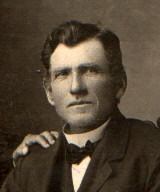
Jacob P. Hiebert

Born: March 29, 1856
Place: Alexanderwohl, Molotschna, Ukraine, South Russia
Died: April 6, 1911
Place: Mosca, Colorado

MOTHER:
Anna Pankratz
FATHER:
Peter Hiebert
SIBLINGS:
Maria Hiebert (3/22/1841 - 2/12/1902)
Elisabet(h) Hiebert (6/24/1843 - 12/4/1863)
Peter P. Hiebert (8/12/1845 - 10/21/1915)
Heinrich P. Hiebert (10/27/1847 - 2/14/1923)
Franz Hiebert (1/13/1850 - 12/31/1855)
Anna Hiebert (12/31/1851 - 10/10/1935)
Helena Hiebert (5/19/1854 - 5/10/1855)
David P. Hiebert (11/15/1858 - 5/26/1933)
Susanna Hiebert (1/2/1861 - 10/24/1961)
Susana Banman [adopted] (1/6/1861 - 11/11/1941)
Johann P. Hiebert (3/22/1863 - 9/19/1915)
Franz Hiebert (5/11/1866 - 5/?/1886)

SPOUSE:
Agnetha (Agnes) Goertz
Married: January 3, 1880
Place: Alexanderwohl Church, Goessel, Kansas
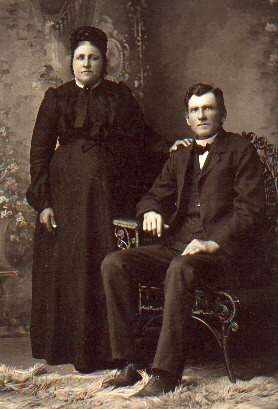
CHILDREN:
Anna Hiebert (11/1/1880 - Unknown)
Jacob G. Hiebert (10/28/1882 - 8/13/1963)
Henry G. Hiebert (3/20/1884 - 7/13/1961)
Mary (Maria) Hiebert (3/23/1886 - 1/17/1970)
Elizabeth (Lizzie) Hiebert (11/28/1888 - 11/15/1976)
Sara Hiebert (1890 - 1890)
Helena Hiebert (4/?/1892 - ?/?/1892)
Reinhardt G. Hiebert (7/?/1894 - ?/?/1894)
Bernard (Ben) G. Hiebert (6/24/1896 - 12/26/1962)

BIOGRAPHY
Jacob P. Hiebert was born in Russia, on March 29, 1856. He came to America in 1874, with his parents, on the ship Cimbrea. On the same ship, was Agnetha Goertz, who also came with her parents. Agnetha was born in Russia on October 23, 1857. Jacob and Agnetha were married on January 3, 1880. They lived on a farm in the Sand Creek community, just east of the Tabor Church. They had 8 children, two of whom died in infancy.
Jacob P. and Agnetha Hiebert lived in the Sand Creek area for many years. In 1910, they sold some of their farm machinery, and farm animals at a public auction, and moved to Mosca, Colorado.
The original auction bill is on the left.
The translation on the right was done by Orie and Frieda Voth.
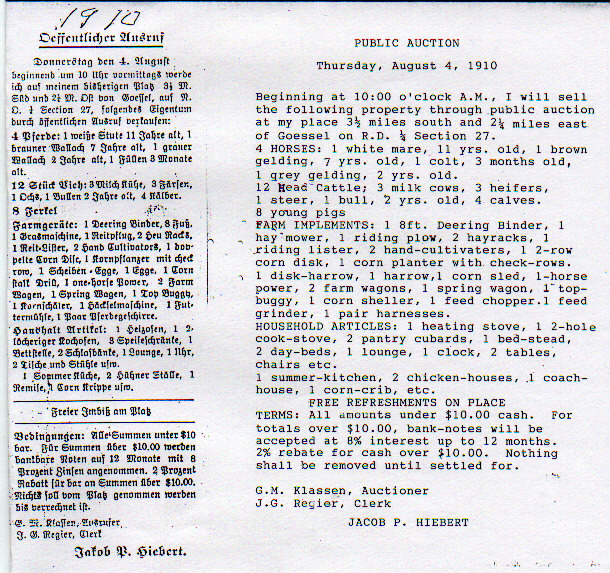
The reason for their moving is not clear, but one of their grandsons thinks that a “land-shyster” talked them into buying some cheap land there, which turned out to be no good. On top of all that, Jacob was kicked by a mule and he died from his injuries. The funeral was held in Colorado and he was buried on their farm near Mosca. This happened in 1911, only about a year after they had moved there. Their son, Ben, and two grandsons visited the grave in 1956, and at that time the gravestone was in bad repair. Mosca is about 13 miles north of Alamosa Colorado. Agnetha, then moved back to Kansas, and lived in a little house in her son Henry’s back yard. On June 19, 1915, she was married the second time to David Voth, a widower, with three adopted grown children. They moved to a house on Main and State Street in Goessel, where they lived the rest of their lives. Daughter Lizzie continued to live in this house until she retired and moved to Bethesda Home in Goessel. Agnetha Goertz Hiebert Voth died August 30, 1933.

Trip to Colorado to Visit Jacob P. Hiebert's Gravesite
Written by Orie and Frieda (Schmidt) Voth
September 1991
We thought that you would be interested in our experiences when we went to Mosca, Colorado to look for Grandfather Jacob P. Hiebert's grave. We arrived in Alamosa close to noon on Sunday, September 15. After we had checked into our Motel, and eaten a little lunch, we drove to Mosca, which is about 13 miles north of Alamosa, on Highway 17. Both, Pete and Bob had given us some directions to go by, and Pete sent us a bunch of pictures. We really appreciated this very much because it helped us to know what to look for. We went to the north corner of Mosca, where there is a sign to the "Great Sand Dunes National Monument". There we went 3 miles east, and ˝ mile north, and found the gravesite on our first try. It is on the east side of the road in a pasture with some cattle in it. There was a gate close by, and we went through the gate to see if we could read the inscription on it. The quality of the stone, and the inscription on it must be very good, because the words on it are still very good and easy to read. It says that Grandfather died April 6, 1911, so that has been a little over 80 years ago.
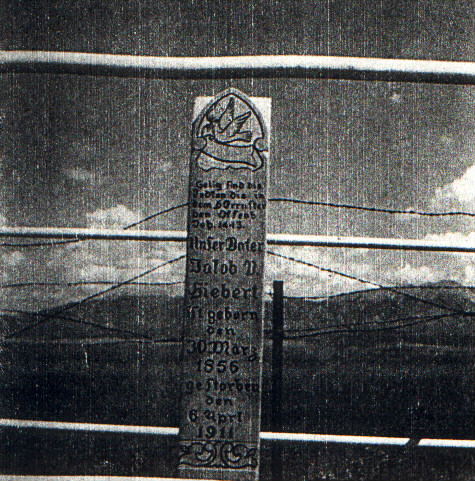
As we were looking at the stone, and preparing to take some pictures, a pick-up drove up and stopped. The man asked if we could read it. We told him that we could, and introduced ourselves. He was Bud Boothe, a farmer, who lived 1 ˝ miles south, and ˝ mile west of the gravesite. We had noticed that someone had built a pipe fence around the stone, and that a fresh cement foundation had been poured, on which the stone had been placed. Also, a few feet away from the pipe fence was a barbed-wire fence built around it.

We had wondered who had done all this, so we asked him. Then he told us that several years ago a certain developer had threatened to dig an irrigation ditch right through the cemetery in Mosca, where some of Mr. Boothe's relatives are buried, and he was not about to let him do that. So, he took him to court and won the case. At that time, 3 persons living in the area, formed a committee to do something to protect all the little gravesites in the Mosca area. So Mr. Boothe, Mr. Gaines Shults, and Mrs. Gladys McKinly were instrumental in putting in the cement foundation, the pipe fence and the barbed fence around Grandfather's grave. We told him that they really had done a good job protecting the stone from the cattle rubbing against it, also in putting in the extra foundation. Mr. Bud Boothe was very glad that he had met us, and he invited us to their house to meet his wife, and visit a little. This valley is called The San Luis Valley, and it has an interesting history as to how it got settled. In fact Bud said that his own grandfather had come over the Mosca Pass with a team of oxen and wagon and settled in the valley many years ago. They showed us an interesting book they had that told about the area and how it was settled. It was an old book, and they said they knew only 3 of the books were still around. Years ago, the owner of "Ye Olde Print Shoppe" in Alamosa had taken one of the books apart, and re-printed it. They didn't know if there were any of those copies still available. We thanked Mr. Boothe for all that the committee had done to preserve Grandfather Hiebert's gravesite.
After we left the Boothe farm, we decided that we would like to go back, and take a few more pictures at the gravesite, and also of the house where Grandfather died, after he was kicked by a horse. Since we had filled the film that we had in the camera, we went back to Alamosa to buy another film, and went back to the area for more pictures. As we were taking the pictures, another pick-up drove up and stopped, and he introduced himself as Gaines Shults, who happened to be one of the committee that preserved Grandfather's gravesite. So, we visited with him and his wife for a while there on the road. He said that the land where the grave is on is owned by a Japanese. This Japanese person and a few others in a company have purchased 50,000 acres in the area, and made a Gulf Course on some of it, and two big ranches on another part of it. Mr. Gaines Shults is leasing the pasture from them, and it is his cattle that is in the pasture. Mr. Shults said that Mrs. McKinly, the third member of the committee that preserved the graves in the area, was an old lady in her nineties that was very forgetful and very hard of hearing. But she had said that she had been a young girl when the Hiebert's had lived there and she could remember very well that Mr. Hiebert had been kicked by a mule, and was brought to their house, and that he had died there.
 The house Jacob Hiebert died in
The house Jacob Hiebert died in
Mrs. Gladys McKinly had lived in the house which is located 1 ˝ miles south of the gravesite. This place is now owned by Gaines Shults, and is renting it to two old ladies who live there at this time. Mrs. Gladys McKinly lives with her son south of Mosca, and we asked if we would be able to visit with her. They said just to call William McKinly, her son, and make arrangements. When we got back to Alamosa & had eaten supper, it was past 8 o'clock, and so we decided that it would be too late to see Mrs. McKinly, so we didn't get to visit with her.
Monday, September 16, we went to the Register of Deeds office in the County Court House, and asked if we could check their records to see if we could find a record of when Grandfather Hiebert bought the land, and from whom, and how much he paid. The lady there was very helpful, and took all the time that we needed. We finally found the name of H.P.P. Schmidt having disposed of the land in 1913. We never found Grandfather Hiebert's name in their records. Alamosa became a county in 1914, so their present records are not very complete. In another book, they found a photocopy of the QuitClaim deed that was signed by H.P.P. Schmidt, and A.P.P. Schmidt. We figured that these people were Aunt Anna and her husband Henry Schmidt. We found the legal description of the 240 acres that Grandfather owned, and Orie has made a drawing of the gravesite, the house where Grandfather died, the Boothe farm, and the Shults farm.
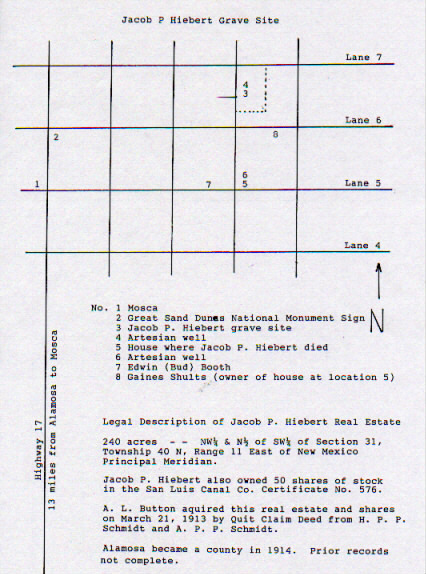
He also put down the legal description of the land where our Grandparents lived and has pointed out the location of an Artesian Well, which is near the gravesite. There are quite a few of these wells in the area, and it was interesting to us to learn about them. We did go to the "Ye Olde Print Shoppe" in Alamosa, and asked if there were any of the reprinted books available of the history of The San Luis Valley, and the lady there went to look, and found one. She said there were only two more copies left. So, we decided to buy one, and learn more about the area where our Grandparents lived. We are still left with questions such as when did Grandfather buy the land, from whom did he buy it, and how much did he pay for it. Also, what kind of farming did they do, what kind of buildings were on the place, where did they go to church, or where was the funeral after Grandfather died. These and other questions remain unanswered. Maybe some others of the cousins will have a chance to go to Mosca, and find out more. It was a very interesting experience, and we are glad that we went.


















